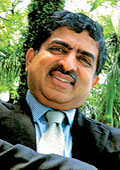 |
| BCCI’s Pawar: The going is tough |
Crises and controversies are not
unfamiliar territory for Sharadchandra Govind Rao Pawar, 66. The
Maratha strongman, as he is often called, a four-time Chief Minister
of Maharashtra, is now Union Minister for Food and Agriculture.
But it's his other job, as President of the Board of Control for
Cricket in India (BCCI), that has kept him in the news recently.
The early exit of Team India from the World Cup has thrown open
the can of worms that is Indian cricket. Perhaps Pawar's instincts
as a politician got the better of those of Pawar the administrator.
All the solutions-from pay cuts for cricketers to the cap on the
number of products a player could endorse to talk of dropping
or "resting" underperforming seniors-reek of populism.
They are also seen as arbitrary and one-sided; Sachin Tendulkar
and Yuvraj Singh have been served notices to explain their comments
on the situation to the media, but coach Greg Chappel's leaks
of team information have been glossed over. Can these measures
really cure Indian cricket? The jury is divided.
Meanwhile, things haven't been going well for Pawar politically.
His party, NCP, which runs Maharashtra in coalition with the Congress,
received a drubbing at the hands of the Opposition Shiv Sena-BJP
alliance in the Mumbai municipal polls, calling into question
the longevity of the Congress-NCP alliance.
These are obviously not the best of times to be in Pawar's shoes.
But the man is a survivor and is known for his canny instincts.
He will need to draw on all of it to ride through the storm that
seems to be enveloping everything he has touched recently.
-Krishna Gopalan
NUMBERS
OF NOTE
$6.5 billion (Rs 27,950 crore):
FDI inflow into India during the October-December quarter, according
to the latest balance of payment figures
28 per cent: Average annual growth
of India's services exports over the last five years. The corresponding
figure for merchandise exports is 22 per cent
1,534,166 sq. km: Total agricultural
land in India
148: New Delhi's rank in human resource
consulting firm Mercer's 215-city Quality of Living Survey. Two
Swiss cities, Zurich (#1) and Geneva (#2), top the list. Mumbai
ranks #209.
$37,668 billion: India's projected
GDP by 2050, almost at par with the projected US GDP of $38,514
billion
Rs 7,310 crore: The projected tech
spending by India's retail industry by 2010
Rs 8,60,000 crore: The total worth
of the Indian food sector
Rs 6 lakh: The annual salary of President
A.P.J. Abdul Kalam; this translates to $13,964. US President George
W. Bush, British PM Tony Blair and Russian President Vladimir
Putin draw $400,000 (Rs 1.72 crore), $370,046 (Rs 1.59 crore)
& $67,464 (Rs 29 lakh), respectively
500,000: Likely shortage of knowledge
workers in India by 2010, according to a McKinsey report
 17:
The number of incidences of load shedding manufacturers face in
a month in India. The numbers for Malaysia and China are 1 and
less than 5 17:
The number of incidences of load shedding manufacturers face in
a month in India. The numbers for Malaysia and China are 1 and
less than 5
70: Percentage of new cars made in
the US that have iPod-compatibility as a standard feature
£2.5 billion (Rs 21,000 crore):
Value of Scotch whisky exported worldwide last year, an all-time
record. Export volumes were also at a new record high of 1.05
billion bottles. The US was the largest destination, and imported
Scotch worth £400 million (Rs 3,360 crore)
NOTED
 ANNOUNCED:
By Infosys Technologies, the appointment of Nandan Nilekani
as Co-Chairman of the company w.e.f. June 22. The boardalso appointed
Kris Gopalakrishnan, COO, President and Joint MD, as CEO and MD,
and S.D. Shibulal as COO. N. R. Narayana Murthy will continue
to be the Chairman. ANNOUNCED:
By Infosys Technologies, the appointment of Nandan Nilekani
as Co-Chairman of the company w.e.f. June 22. The boardalso appointed
Kris Gopalakrishnan, COO, President and Joint MD, as CEO and MD,
and S.D. Shibulal as COO. N. R. Narayana Murthy will continue
to be the Chairman.
RECORDED: By the Index of Industrial Production
(IIP), a growth of 11 per cent during February 2007, against 8.8
per cent in the correspondoing month last year. The manufacturing
sector improved by 12.3 per cent in February compared to 9.2 per
cent in the same month of 2006. However, the poor performance
of the electricity sector acted as a dampener and restricted the
overall growth rate.
 TWEAKED:
By the Government of India, the import norms for motor-cycles
to allow the import of 800 cc and higher Harley Davidsons from
the US; these bikes will have to adhere to Euro III emission norms.
Thus far, India had restricted the imports of high capacity bike
as there are no local facilities to test the vehicles. TWEAKED:
By the Government of India, the import norms for motor-cycles
to allow the import of 800 cc and higher Harley Davidsons from
the US; these bikes will have to adhere to Euro III emission norms.
Thus far, India had restricted the imports of high capacity bike
as there are no local facilities to test the vehicles.
RANKED: By Deloitte Tax LLP, India as
the world's eighth-largest market for M&A deals in the first quarter
of 2007. It ranked 11th in 2006. The figures for the first quarter
are 83 per cent higher than that of the full year figures of last
year which were at $13.97 billion (Rs 60,071 crore). India has
surpassed China and South Korea in the Asian league table and
is only behind Japan in the M&A market.
REDUCED: By Bajaj Auto, the price of 100
cc Platina by Rs 3,000 to Rs 33,000. The bike is Bajaj's last
remaining 100 cc offering in the Indian market. The company has
already announced its plans to exit this segment. The offer was
made possible by the tax cuts and excise incentives offered by
Uttarakhand where it has set up a new plant.
CROSSED: By India's foreign exchange reserves,
the $200-billion (Rs 8,60,000-crore) mark for the first time.
Forex reserves for the week ended April 6 stood at $200.34 billion
(Rs 8,61,462 crore), giving India the #7 spot among emerging markets.
So
Far So Good
The passenger vehicle market grew
20.7 per cent in 2006-07 to 1,379,698 vehicles. Production facilities
for over 1 million additional cars were spoken about and Maruti
inaugurated its brand new facility at Manesar, Haryana. But with
interest rates rising, was 2006-07 the top of the cycle? That
will only be answered over time though March numbers for mid-sizers
did take a slight tumble and two-wheeler sales growth has begun
to taper off already. But until then, munch on these juicy numbers
for the year.
-Kushan Mitra
IT
COS RAMP UP FOREIGN ROLLS
 |
| Foreign interns: Part of Indian strategy |
The Infosys leadership institute,
located on the company's 315 acre campus in Mysore, is becoming
a key cog in the company's globalisation strategy. It is, at any
given point in time, the temporary home to well over 100 American
interns and has evolved into something of a calling card for an
industry trying to play down the threat of job losses in the West.
"We will hire 300 Americans over the next year," says
T.V. Mohandas Pai, ED and Head of Education & Research at
Infosys.
Its cross-town rival, Wipro, meanwhile, has announced plans
of recruiting 500 employees in the UK over the next year. "The
expansion is part of a strategic initiative to build a strong
local presence there," says Sudip Banerjee, President of
Wipro's Enterprise Solutions Division. Cognizant, too, is ramping
up its roster of local recruits in Europe.
This will do much to assuage local trade unions such as Amicus
in the UK that have been critical of the Indian IT sector for
allegedly taking jobs away to low cost centres in India. But there
are allegations that Indian IT companies pay less than the industry
average in these countries, a claim denied by industry executives.
"We have to compete for the same talent in the UK and the
US and can't afford to offer sub-standard pay," says Infosys'
Pai.
-Rahul Sachitanand
|






 17:
The number of incidences of load shedding manufacturers face in
a month in India. The numbers for Malaysia and China are 1 and
less than 5
17:
The number of incidences of load shedding manufacturers face in
a month in India. The numbers for Malaysia and China are 1 and
less than 5  ANNOUNCED:
By Infosys Technologies, the appointment of Nandan Nilekani
as Co-Chairman of the company w.e.f. June 22. The boardalso appointed
Kris Gopalakrishnan, COO, President and Joint MD, as CEO and MD,
and S.D. Shibulal as COO. N. R. Narayana Murthy will continue
to be the Chairman.
ANNOUNCED:
By Infosys Technologies, the appointment of Nandan Nilekani
as Co-Chairman of the company w.e.f. June 22. The boardalso appointed
Kris Gopalakrishnan, COO, President and Joint MD, as CEO and MD,
and S.D. Shibulal as COO. N. R. Narayana Murthy will continue
to be the Chairman. TWEAKED:
By the Government of India, the import norms for motor-cycles
to allow the import of 800 cc and higher Harley Davidsons from
the US; these bikes will have to adhere to Euro III emission norms.
Thus far, India had restricted the imports of high capacity bike
as there are no local facilities to test the vehicles.
TWEAKED:
By the Government of India, the import norms for motor-cycles
to allow the import of 800 cc and higher Harley Davidsons from
the US; these bikes will have to adhere to Euro III emission norms.
Thus far, India had restricted the imports of high capacity bike
as there are no local facilities to test the vehicles. 